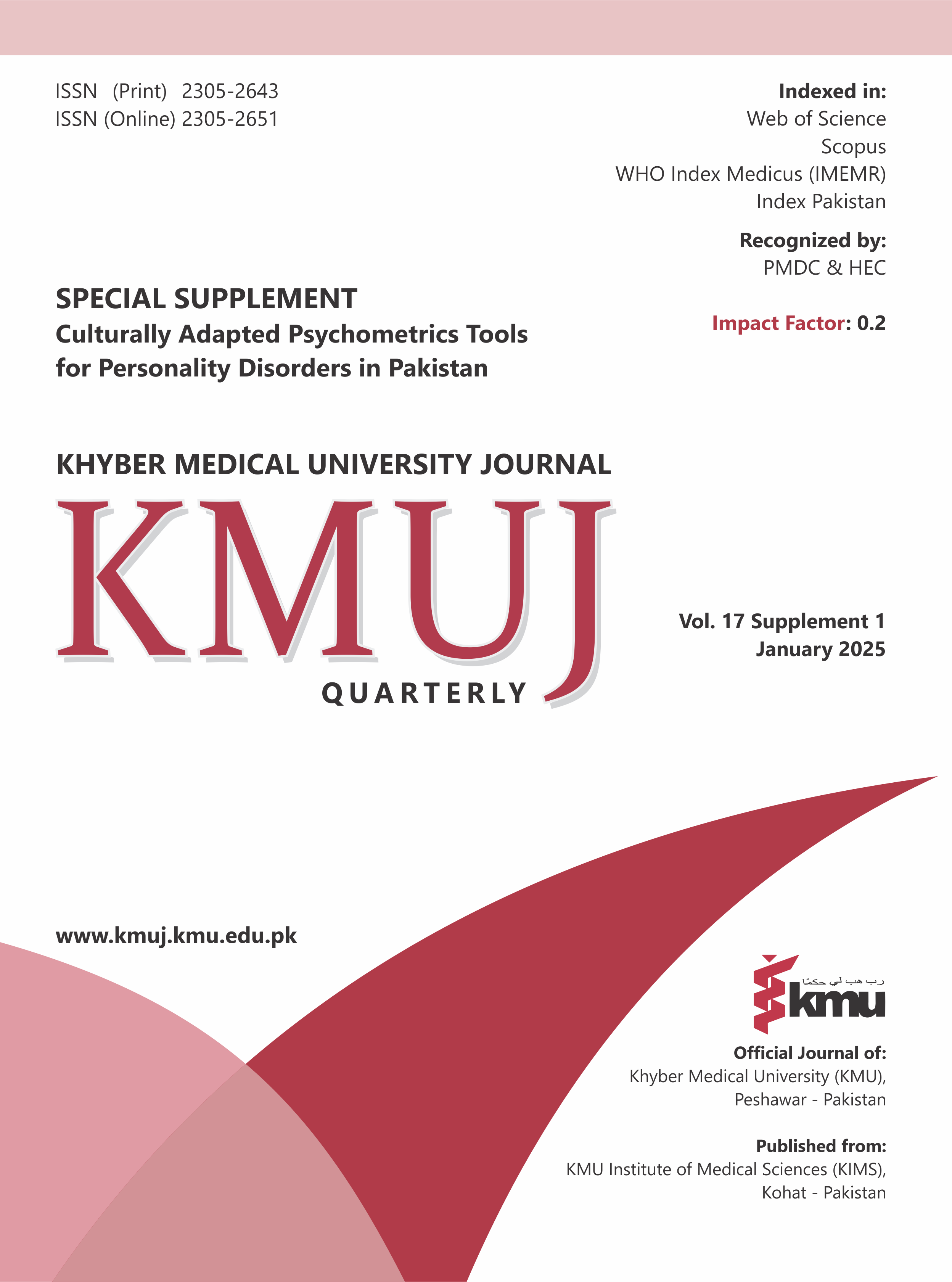Development and validation of an indigenous self-rating Narcissistic personality disorder scale for adults in Urdu language
Main Article Content
Abstract
Objectives: To develop and validate an Urdu-language narcissistic personality disorder (NPD) scale for adults, ensuring robust psychometric properties aligned with Pakistan's cultural context.
Methods: The study was conducted in two phases. In the first phase of the study, a total of 234 participants, aged 19 years and above, were recruited using purposive sampling. The sample included both male and female individuals from clinical and non-clinical populations, drawn from various communities and institutions in Gujrat, Pakistan. An initial pool of 75 items was developed and administered to these participants. Following a systematic scale development process, the final version of the scale was refined to a 25-item self-report questionnaire. In the second phase, the psychometric properties of the scale were evaluated through reliability and validity testing.
Results: Exploratory Factor Analysis (EFA) revealed a nine-factor structure, while Confirmatory Factor Analysis (CFA) refined this to an eight-factor model with an acceptable model fit (CFI=0.926). The scale demonstrated strong psychometric properties, including high internal consistency (α=0.922). The newly developed scale showed significant convergence with the Short Measure of Dark Triads narcissism subscale (r=0.570**). The findings support the scale as a promising diagnostic tool for clinical and research purposes.
Conclusion: Narcissistic Personality Disorder scale is a reliable and valid tool designed to diagnose NPD, overcoming cultural and linguistic barriers by being developed in Urdu. This measure offers utility for researchers and clinicians working in diverse settings.
Article Details

This work is licensed under a Creative Commons Attribution 4.0 International License.
Work published in KMUJ is licensed under a
Creative Commons Attribution 4.0 License
Authors are permitted and encouraged to post their work online (e.g., in institutional repositories or on their website) prior to and during the submission process, as it can lead to productive exchanges, as well as earlier and greater citation of published work.
(e.g., in institutional repositories or on their website) prior to and during the submission process, as it can lead to productive exchanges, as well as earlier and greater citation of published work.
References
1. Schmidt A. Comparison of kernbergs and kohuts theory of narcissistic personality disorder. Turk Psikiyatri Derg 2019;30(2):137-41.
2. Meyer B, Pilkonis PA. Attachment Theory and Narcissistic Personality Disorder. The handbook of narcissism and narcissistic personality disorder: Theoretical approaches, empirical findings, and treatments. Publisher: Hoboken, NJ: John Wiley and Sons. 2012; 434-44. https://doi.org/10.1002/9781118093108.ch39
3. Pincus AL, Lukowitsky MR. Pathological narcissism and narcissistic personality disorder. Annu Rev Clin Psychol 2010;6:421-46. https://doi.org/10.1146/annurev.clinpsy.121208.131215
4. Pincus AL. The pathological narcissism inventory, in understanding and treating pathological narcissism. Am Psychol Assoc 2013;93-110. https://psycnet.apa.org/doi/10.1037/14041-006
5. Schalkwijk F, Luyten P, Ingenhoven T, Dekker J. Narcissistic personality disorder: Are psychodynamic theories and the alternative DSM-5 model for personality disorders finally going to meet? Front Psychol 2021;12:676733. https://doi.org/10.3389/fpsyg.2021.676733
6. American Psychiatric Association. Diagnostic Statistical Manual for Mental Disorders. 5th ed. Arlington, V.A: American Psychiatric Publications 2013; 669-71.
7. Caligor E, Levy KN, Yeomans FE. Narcissistic personality disorder: Diagnostic and clinical challenges. Am J Psychiatry 2015;172(5):415-22. https://doi.org/10.1176/appi.ajp.2014.14060723
8. Bardenstein KK. The cracked mirror: Features of narcissistic personality disorder in children. Psychiatr Ann 2009;39(3):147-55. https://doi.org/10.3928/00485713-20090301-01
9. Campbell WK, Reeder GD, Sedikides C, Elliot AJ. Narcissism and comparative self-enhancement strategies. J Res Pers 2000;34(3):329–47. https://doi.org/10.1006/jrpe.2000.2282
10. Ronningstam EF, Weinberg I. Narcissistic personality disorder: progress in recognition and treatment. Focus 2013;11(2):167-77. http://dx.doi.org/10.1176/appi.focus.11.2.167
11. Pincus AL, Lukowitsky MR. Pathological narcissism and narcissistic personality disorder. Annu Rev Clin Psychol 2010;6:421-46. https://doi.org/10.1146/annurev.clinpsy.121208.131215
12. Russ E, Shedler J, Bradley R, Westen D. Refining the construct of narcissistic personality disorder: Diagnostic criteria and subtypes. Am J Psychiatry 2008;165(11):1473-81. https://doi.org/10.1176/appi.ajp.2008.07030376
13. Stinson FS, Dawson DA, Goldstein RB, Chou SP, Huang B, Smith SM. et al. Prevalence, correlates, disability, and comorbidity of DSM-IV narcissistic personality disorder: results from the wave 2 national epidemiologic survey on alcohol and related conditions. J Clin Psychiatry 2008;69(7):1033–45. https://doi.org/10.4088/jcp.v69n0701
14. Grijalva E, Newman DA, Tay L, Donnellam M, Harms PD, Robins RW, et al. Gender differences in narcissism: a meta-analytic review. Psychol Bull 2015;141(2):261-310. https://doi.org/10.1037/a0038231
15. Likert R. A technique for the measurement of attitudes. Arch Psychol 1932;22(140):5-55.
16. Tay L, Jebb A. Scale Development. In S. Rogelberg (Ed), The SAGE Encyclopaedia of Industrial and Organizational Psychology. 2nd ed. Thousand Oaks, CA: Sage; 2017.
17. Rahn M. Factor Analysis: A Short Introduction, Part 5–Dropping unimportant variables from your analysis 2018. [Accessed on: June 30, 2019]. Available from URL: https://www.theanalysisfactor.com/fa ctor-analysis-5/
18. Zainudin A. A Handbook on SEM: Structural equation modelling using amos graphics. 4th ed. Validating the Measurement Model: CFA 2012:54-73.
19. Gliem JA, Gliem RR. Calculating, interpreting, and reporting cronbach’s alpha reliability coefficient for likert-type scales. Midwest research to practice conference in adult, continuing, and community education. 2003. [Accessed on: June 30, 2019]. Available from URL: http://hdl.handle.net/1805/344
20. Hinkin TR, Tracey JB, Enz CA. Scale Construction: Developing Reliable and Valid Measurement Instruments. J Hosp Tour Res 1997;21(1):100-20. https://doi.org/10.1177/109634809702100108
21. Jones DN, Paulhus DL. Introducing the short Dark Triad (SD3): a brief measure of dark personality trait. Assessment 2014;21(1):28–41. https://doi.org/10.1177/1073191113514105
22. Gul-e-Sehar, Fatima I. Dark triad personality traits as predictors of bullying and victimization in adolescents. J Behav Sci 2016;26(1):51-65.
23. Thomaes S, Bushman BJ, Stegge H, Olthof T. Trumping shame by blasts of noise: narcissism, self-esteem, shame, and aggression in young adolescents. Child Dev 2008;79(6):1792-801. https://doi.org/10.1111/j.1467-8624.2008.01226.x
24. Thomaes S, Stegge H, Bushman BJ, Olthof T, Denissen J. Development and validation of the childhood narcissism scale. J Pers Assess 2008;90(4):382-91. https://doi.org/10.1080/00223890802108162
25. Glover N, Miller JD, Lynam DR, Crego C, Widiger TA. The five-factor narcissism inventory: a five-factor measure of narcissistic personality traits. J Pers Assess 2012;94(5):500-12. https://doi.org/10.1080/00223891.2012.670680
26. Pincus AL, Ansell EB, Pimentel CA, Cain NM, Wright AGC, Levy KN. Initial construction and validation of the pathological narcissism inventory. Psychol Assess 2009;21(3):365-79. https://doi.org/10.1037/a0016530
